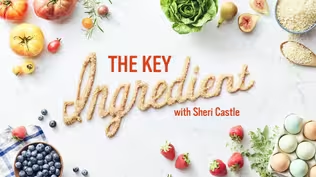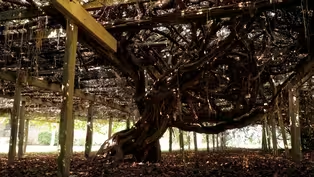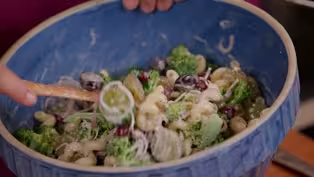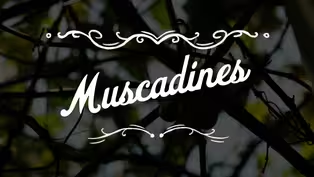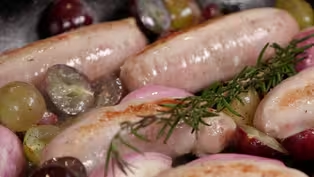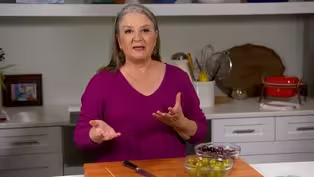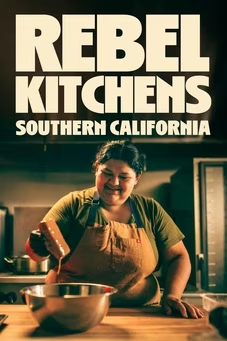
Muscadine Mood
9/11/2023 | 26m 13sVideo has Closed Captions
Sheri is in a mood to share her joy of cooking with marvelous muscadines.
Sheri is in a mood to share her joy of cooking with muscadines. These tangy and tasty native grapes showcase beautifully in Sheri’s broccoli pasta salad with muscadines in a delicate poppyseed dressing, while a savory skillet of roasted muscadines and sausage make for a delicious one-pan meal for everyone. Sheri pays a visit to the muscadine mother vine and bakes a muscadine and peanut pie.
Problems playing video? | Closed Captioning Feedback
Problems playing video? | Closed Captioning Feedback
The Key Ingredient is presented by your local public television station.

Muscadine Mood
9/11/2023 | 26m 13sVideo has Closed Captions
Sheri is in a mood to share her joy of cooking with muscadines. These tangy and tasty native grapes showcase beautifully in Sheri’s broccoli pasta salad with muscadines in a delicate poppyseed dressing, while a savory skillet of roasted muscadines and sausage make for a delicious one-pan meal for everyone. Sheri pays a visit to the muscadine mother vine and bakes a muscadine and peanut pie.
Problems playing video? | Closed Captioning Feedback
How to Watch The Key Ingredient
The Key Ingredient is available to stream on pbs.org and the free PBS App, available on iPhone, Apple TV, Android TV, Android smartphones, Amazon Fire TV, Amazon Fire Tablet, Roku, Samsung Smart TV, and Vizio.
Providing Support for PBS.org
Learn Moreabout PBS online sponsorship[upbeat music] - We are in a muscadine mood.
There is no other beloved fruit, with its own mystery mystique, than the muscadine.
We traveled to the mother of all vines, on Roanoke Island that dates back over 400 years, as an original native muscadine source.
Don't miss this mouthwatering roasted sausage with muscadines and my modern twist on a vintage recipe of muscadine, broccoli and pasta salad, in poppy seed dressing.
We are in the kitchen with talented baker and food writer, Keia Mastrianni to make her famous peanut butter and jelly pie, using grapes from her backyard vine.
You are the best pie person I will ever know.
[Keia laughing] - It's good to have pie people in your life, that's for sure.
- I'm Sheri Castle.
I write cookbooks, I write for food magazines, I cook, I teach and I collect stories.
And my favorite stories are the ones behind our best loved home recipes.
Is it time to shuck 'em?
- It's time to shuck 'em.
Cheers.
- [Sheri] Oh, that's awesome.
I will go out and explore from the ground up the best ingredients that go in to some of our most beloved family recipes.
It's all about the food, the flavors and finding the key ingredient.
[upbeat music] If you've never heard of a muscadine, I'm happy to share its wonders.
It's a great ingredient, full of flavor and you might say "zing".
Muscadines are used for jams, baking and also wine-making.
Now, here's the fun fact.
All scuppernongs are muscadines, but not all muscadines are scuppernongs.
The very first known muscadine vine, is believed to be on Roanoke Island on the outer banks of North Carolina and it dates back over 400 years.
It's a marvel and I'm so happy to see it and hear about its history from the current keeper of the vine.
- My name is Carl Curnutte and I'm the keeper of the vine.
John Wilson, son of Estelle and Jack Wilson, who actually built the home here and actually became keepers of the vine, was looking somebody to sort of take over the property.
And so it was a perfect, wonderful opportunity, was planning on building a home and came and visited and said, "Oh my heavens, I mean, this is the most spectacular view" and then on top of it to be blessed with having 'The Mother Vine' in your front yard".
I'm a great lover of history, having been the producer of "The Lost Colony".
I'm now the Executive Director of "The Elizabethan Gardens" and I thought, you know, how wonderful to have this piece of history in your yard?
- Hello, hello!
How are you?
- [Carl] It's so good to have you here at "The Mother Vine"!
- I am delighted to be here.
So, I have driven on what feels like a pilgrimage to the complete end of the United States, to be in this spot.
Tell me where I am.
- [Carl] Well, you are at the oldest producing grape vine in North America.
- Okay yeah, that's a big sentence right there.
[Carl laughing] Tell me, tell me what kind of grape this is, let's start there.
- This is muscadine - Uh-huh.
- and this grape has actually been producing, we think from the 16th century, when the colonists actually came in 1587.
Some think that it was actually brought here by the lost colonists.
Some say the Native Americans actually harvested the grapes that were actually here, the Algonquin, Indians that were actually here on the island, but it is the oldest producing in North America.
- That's amazing.
So, we've got these ends here, but I can't help, but look over my shoulder that I think, that truly the root of this story is right up under this trellis.
- [Carl] You're absolutely right and there are three major root systems that are with this vine and that has been living for over 400 years.
- [Sheri] So, the trellis that we are crawling under, is that just to lift some of the weight of the grapes off the vine, is it good for the air to circulate?
Why do you trellis them?
- Actually, what we have found out is that the the older layers of the great vine, it's important to allow that to stay.
It used to be, you know, in the past, they'd say, "Clear some of that out".
It's actually good for them to be able to have that.
And you need the trellis to be up and lifted, so that you can take it off the ground, it also helps with the animals, those sort of things, to be able to get the grape.
It also protects the root system, so the vines actually growing up.
- But the vine decided this, no one did this, so far as you know?
- No, you don't train it, not that I'm aware of, there's no training to it.
This is actually how it grows.
[upbeat music] - Got a bowl from "The Mother Vine" and I see some that are bright green, some that are a little muddier, some a little slicker, some a little more wrinkled-like.
Which ones should I pick?
- Age of the grape and I would say, it's the individual choice.
The one thing about this grape, is it makes you work a little harder.
You know, growing up, you just pop a grape in, eat the whole thing.
Here, what's really important, is what's inside the grape, versus the tough skin that's on the outside of the grape.
- [Sheri] But you eat that part, too?
- Oh, I'll eat it all.
- Okay.
- Not the seed, - I'm not a fan of seeds, but you can.
- Okay.
- Just like some people eat watermelons and eat the seeds, so it's- - All right, so I'm going in and we'll go see what happens.
It feels like I picked a movie to watch, but I didn't really know what it was about, 'till I got into it.
[Sheri and Carl laughing] - [Carl] I love that.
- That is so interesting.
There's the crunch of the skins, then there's the burst of juice and the outside is really sweet, but there's a tang, like an earthy tang.
If a summer night, at the beach had a taste, - This is what it would be.
- I think it would be it.
- Yeah, yeah I really do.
- It definitely has a very unique taste.
- [Sheri] It is the state fruit of North Carolina.
- [Carl] That's right, absolutely.
- [Sheri] And you get to live here.
- [Carl] I know, it's amazing.
- Let's have a grape.
- Absolutely, let's have a grape.
[upbeat music] - If you've never had roasted grapes before, haven't made them at home or had them served to you, you are in for a treat.
It could not be more simple, but it's an elegant way, that's gonna dress up any dish.
And it's the star of this next one, a wonderful way to try out roasted grapes.
So, I've preheated my trusty cast iron skillet and I'm gonna add a pound of fresh sausage.
Now, it can be poultry sausage, it can be pork, it can be hot, it can be mild.
It can be whatever you like, but it does need to be fresh.
A precooked sausage just doesn't work in this recipe.
So, I'm gonna put these in my skillet and let them brown a little bit, just a couple of minutes on each side, to give them a little jumpstart on the cooking.
[sausages sizzling] And while those brown, we're gonna get our grapes ready.
So, I am using two different colors of muscadines, these beautiful wine-colored black ones, some people call it and some of the lighter color ones that some people call scuppernongs.
You can do a mixture and you can do either one, but for these, I've cut them in half and taken out their seeds.
And then I have some shallots.
All I did to these, was cut 'em in half and there's a tiny bit of the root in, still left on, so that the pieces will hold together.
Got a splash of olive oil and you don't wanna make 'em oily, but you do wanna moisten them up, just a little bit, to get them ready to go into the pan and I'm gonna do the same thing with my grapes.
Just a little splash of oil, a good pinch of salt and two good pinches of pepper.
I'm gonna add the rest of my grapes to my bowl.
And I'm gonna cook these for one to two minutes on each side.
We're not trying to cook them through, that'll happen in the oven, just to give them a little bit of color.
So, I have my oil on my grapes and on my shallots, my salt and pepper and now this goes in the skillet.
I'm gonna put my shallots cut side down, so that they can get all toasty and brown as they roast.
And then when it comes to the grapes, just scatter them around, no rhyme or reason, just put 'em in the pan.
Drop in a sprig of rosemary for a little herbaceous flavor and it's off to the oven.
[upbeat music] So, it's been about 15 minutes, just long enough for the sausages to cook through and it's time to get it out from the oven.
So, look what we have here.
We have perfectly brown sausages and we have these little sizzley grapes.
I love that some of them have broken apart, and turned into little jammy bits.
Some have held their shape, they're a little soft, they're a little frizzled on the edges, a whole range of flavors and textures.
And now, I'm gonna make myself a little plate the way that I love to eat this.
Step one, throw away this poor old rosemary, it has given it's all.
So, I'm gonna start with one of these great sausages.
And then I'm gonna take my spoon and I'm going to scrape up some of these amazing grapes.
Some of the ones that are a little soft, some of the ones they're a little sizzley and at lease one of these delicious shallots, it has gotten golden and toasty while it was in the oven.
And then, I'm gonna take a tiny bit more rosemary, just a little sprinkle to freshen that up.
And then here are my companion pieces that I can't resist, got to have some cheese.
So, I have a nice ripe Brie, add that to my plate.
Some toasty, crusty, delicious bread and then last, but not least, a little bit of mustard.
I love how the mustard gives a little bright, crunchy note to everything else that's going on.
And if you happen to have it on hand, a little balsamic vinegar, just a drop or two over the top of the grapes, it's gonna mix with those delicious roasty jam-like juices.
This is a keeper, you're gonna love it.
[upbeat music] ♪ It's ready ♪ ♪ Yes it's ready ♪ ♪ So just let it all begin ♪ [Upbeat music] Pie is love and love is pie.
That's the motto of my talented pie-making friend, Keia Mastrianni.
In her kitchen we're making an inventive muscadine pie, that is truly a revelation.
[upbeat music] - [Keia] Hey Friend!
- [Sheri] I'm so happy to be here!
How are you?
- [Keia] I'm doing well, how are you?
- [Sheri] I'm fine, we've got sunshine, we got you, it's gonna be a good day.
- [Keia] Yeah and we've got pie.
- [Sheri] Pie!
- [Keia] Everything's better with pie!
Come on in.
- I love your pie space.
What do you call this magical room of piedom, here?
- Well, this is the home of "Milk Glass Pie", it's my little cottage bakery, that I built here on our farm.
- And you are the most pie person I've ever met.
How did you fall in love with pie?
- I think I fell in love with pie, because I fell in love, period.
My partner, Jamie Swofford, he is a farmer and we met, because I wrote a story about him one time.
And our first Christmas together, he had given me a pie book and in the inscription it said, "Love is pie" and you know, I was just filled with love and I just had to put it in the pie, just kept baking pie and baking pie and baking pie.
- I love that.
So, your combinations are so creative, you're known for that.
Now, it's muscadine season, so you're bound to be doing some fabulous things with muscadines.
- We've got muscadine vines here on the farm, so we just have them in abundance.
I had this idea to do something that was akin to peanut butter and jelly.
So, I created a "PB&J Pie" with muscadines, which is, you know, nostalgia for me.
Once we pick the muscadines off the vine, there's a process of kind of separating the pulp from the skins, because there's a seed inside that muscadine grape, so we've got to kind of get that out.
So, we have the muscadine pulp, we've got the skins, which is where all the flavor lives and then we usually recombine them in order to make the filling in.
And I usually add spices and sugar and we cook that filling down for this pie.
I always like to combine the dry ingredients together, especially when I'm using cornstarch.
Like if you're not careful, it gets a little clumpy if you're adding it to liquid, so I've got some light brown sugar and granulated sugar, a half a cup of each.
- Now, why are you using two sugars?
Is that for flavor, is that for thickness?
- I just always mix them, 'cause I just think it makes a better pie.
- If you tell me it makes a better pie, I'm sold.
- A half teaspoon of allspice, a half teaspoon of ginger and a quarter teaspoon of cinnamon.
I've got a half a teaspoon of kosher salt and then we're gonna thicken this on the stove top.
So, we're gonna use a quarter cup, plus one tablespoon of corn starch.
And I normally give that a, a mix.
I love using my hands when I'm mixing sugar in spices, I think that this gives you the opportunity to get any sort of clumps out.
- [Sheri] We've got a lot of info coming through those fingertips, don't we?
- So, this is two pounds worth of muscadine filling, just add it in to here.
And I will just kind of mix it in.
Then we've got two tablespoons of lemon juice, a quarter cup of Old North Shrub.
- [Sheri] For people that have never had a shrub before, what is that?
- Shrub is fruit, vinegar and sugar.
And shrub is my secret ingredient.
- [Sheri] Well, you know, as they say at home, "That is 40 kinds of fabulous".
[Keia laughing] - And I normally just kind of stir that up together.
I usually let it come to a full boil.
I just kind of pour it out onto a sheet pan, to let it cool, because we will add some egg to bind the filling and I don't wanna cook the eggs, I want that filling to be all the way cooled.
- [Sheri] You are the queen of crimp, of all crimpdom.
What did you do, to pre-bake it?
- With any pie shell that I prebake, the pie shell gets frozen, I cover it in tinfoil and then I usually add some type of pie weight into the shell and I fill it all the way up to the top.
- And the pre-baking kind of seals it, so that this filling is not gonna sog out the bottom, right?
- Correct, we do not like soggy bottoms in this house.
- Ew, no soggy bottoms.
[Sheri and Keia laughing] - That's it.
- [Keia] That's it.
So, we're gonna just add this cooled filling to the pie shell.
- So, how do we put the PB in the PB&J?
- With this peanut butter, oat crumble.
- So, how did you get the little lumpy bits?
- [Keia] I refrigerate my crumble.
- [Sheri] There you go and that butter sets back up?
- [Keia] That's it.
- I've always loved a crumble on top of a great pie, - [Keia] Hm, uh hm.
- but I sure didn't think - [Sheri] of peanut butter.
[upbeat music] That is ridiculously good.
- [Keia] Thank you, my dear.
- You are the best pie person, I will ever know.
[Keia laughing] - It's good to have pie people in your life, that's for sure.
- Uh hm.
- Yeah.
- I'd love you without the pie, but this helps.
[Keia and Sheri laughing] - Yeah, right.
- Good Lord, that's good!
My whole life, I have loved a good pasta and vegetable salad.
And when I was growing up, there was one that my grandmother made, it had broccoli in it and some grapes.
Well, I had updated that, this is how you make it.
So, I have a pot of vigorously boiling water, and I'm gonna add quite a bit of salt.
One of the keys to making pasta for this recipe or for any, is to generously salt the water, add what you think it's gonna need and a little bit more.
They say it should taste like ocean water, when it's ready.
And I'm gonna add in, my pasta.
I'm using this really attractive, delicious squiggly curly shape and you can use any shape you want, so long as it's short and stubby.
You want something that's gonna hold these ingredients, not long thin strands.
Now, put that in the boiling water, I'm guessing six minutes.
So, when your pasta is about two minutes short of being perfect, we're gonna add the broccoli, so it can cook in the same water.
This broccoli isn't going to cook completely, it's gonna cook only 'till it's crisp tender.
I like it when a little bit of that raw edge has been taken off, but while it still retains all of its great color and crunch.
So, 90 seconds, two minutes, let your broccoli tell you what it needs.
[upbeat music] So, about two minutes later, your pasta is gonna be al dente and your broccoli is gonna be crisp tender and we're gonna take it out of that boiling water.
You wanna drain this really well, because one of the keys to a great pasta-based dish, is for there to be no clinging moisture, before you add your dressing, or your sauce.
Now, some people would say, "Well, why don't I just rinse it?
", well, rinsing is gonna make your pasta gummy and it's gonna make your broccoli sad.
So, I like to let gravity and about two minutes of time, do the job for me.
So, we're gonna let this sit, until the steam stops billowing.
It'll take just enough time for us to be able to make our great dressing.
Now, I'm going to actually make my dressing in the bowl I'm gonna serve the entire dish, to cut down on the number of dirty dishes.
Now, this is my version of poppy seed dressing.
The base is mayonnaise.
Now, the mayonnaise is going to sort of dissolve in the recipe, but it's gonna give us a rich creaminess, that's gonna coat every little squiggle in that cute curly pasta.
And then we're gonna add some sugar, then we have some sherry vinegar, gonna make this sweet and tangy, all at the same time.
And this is powdered mustard.
What some recipes of what I always call "dry mustard", but some people call it "powdered mustard" and then we have poppy seeds and then salt and pepper.
And now, all we have to do, is stir it together until it's nice and creamy.
And now, it's time for our pasta and our broccoli to go in.
So, it's no longer screaming hot, a lot of the moisture has cooled down and steamed off, but it's still a little bit warm and that's one of my secrets to a great pasta salad, is you let the pasta go into the dressing, before it's completely cold, because it's gonna absorb a lot of that flavor, as it finishes cooling down.
Give it a good stir and then we're gonna add what gives this recipe, its special edge and that's our muscadines.
So, when it comes to muscadines, we have choices.
There are black ones, red ones and bronze ones, they can look a little bit green and any of those gonna be great in this recipe.
So, the trick is to find the muscadine that's in the best form where you are.
There's also a new muscadine.
There's over 150 different kinds and apparently there's room for one more, because lately there are these tiny little muscadines.
And what makes them separate from the others is, they don't have seeds, which make them a great addition to a recipe like this, because all you have to do, is put 'em in the bowl.
But, I like to mix things and get a little of all of them.
So, I also have some of the traditional ruby-colored, the black ones, the beautiful wine-colored ones and for these, you're gonna wanna cut 'em in half and pick out the seeds, it takes only a couple of minutes.
And last, but not least, we have some of these beautiful bronze, green ones.
Now, some people say that if they're green, or bronze, they're scuppernongs, whereas the dark color ones are muscadines, I don't really know.
I think it depends on where you grew up and what you call your grapes, I just know that they all taste delicious.
The perfume of these are amazing.
You always know you have a great muscadine, if it makes the whole house smell good.
And now, for a little bit of a savory edge, we have some finely sliced shallots and we're gonna fold it together.
Now, when you start stirring this, you may say, "There is not enough dressing, there is no way that that's enough dressing on here".
Oh yes, it really is, because we're gonna put this in the refrigerator and let it chill, which will take a good two hours.
You could even do it a day ahead and what's gonna happen is all of these amazing flavors are gonna come together.
They're all gonna come to the party and this dressing's gonna firm up a little bit and perfectly coat each nook and cranny, noodle squiggle, every good grape.
Now, this is good and chilled.
It was in the refrigerator for a couple of hours, but you could do this the night before, to get a headstart.
We have two more great ingredients to go in and I saved those until the last, so that they'll remain crunchy and add a little bit of different texture to this salad.
The first is, some pecans.
Just chopped, nicely chopped pecans, or you can use halves, if you want to and then, some smokey bacon.
But if you want to keep this meatless, no worries.
There's plenty going on in this bowl, already.
And we're gonna stir that in and this salad is ready to eat.
And I think it's time to taste it.
So, we have our crunch, we have our sweet, we have some savory, we have some tangy, all together.
I'm going in.
[upbeat music] You know, that is so good, you can taste everything individually and then it comes together in one magnificent bite.
And the star of the show, is the muscadine.
No other grape tastes like a muscadine.
It's sweet, it's earthy, it has its own aroma, that is somehow part of its flavor.
A muscadine isn't just a fruit, it's its own season.
In North Carolina, we know it's September, not by the calendar, but when it's muscadine time.
[upbeat music] [playful music] So, at the very first glance at a bowlful of muscadines or scuppernongs, you know, this is no ordinary grape.
They're rounder than most table grapes, they also have thick skins and they're full of seeds.
Now, the seeds need to come out for a lot of recipes and it's not that hard.
Here's how I like to do it.
So, you wanna cut the grape with a serrated knife, if you have one handy, from the stem down.
And the grape will tell you if you're going the wrong way, because you can actually feel those seeds under the tip of the knife.
Now, once it's cut in half the seeds reveal themselves, they're not gonna hide, they're there in plain sight and you just take your finger, or what I like to do, is to take the tip of a wooden skewer, or a toothpick and just pry those babies out of there.
That's it.
They grow in a pattern, you're not gonna have to go fishing around for them.
There's about four per grape and out they come.
And that's how you remove the seeds from these delicious muscadines.
[playful music] [upbeat music] Muscadines are a wonderful ingredient.
I am so glad we were able to hear their history and cook with these gems.
They're inspiring, distinctive and sure to be the hit of your next recipe.
Now, is there an art to spit the seeds on people, or away from people, - or anything like that?
- Not that I'm aware of.
- [Sheri] Okay.
- My mother would probably say, "We shouldn't spit the seeds".
- I think we ought to work on it, don't you?
Arch, distance, array... [Carl laughing] - We need to begin a whole new competition for the outer banks.
- [Sheri] You know what, nothing, it is impossible to eat just one.
- [Carl] Absolutely.
- 'Cause it's just like- - Well look.
- We have a whole bowl.
- I can think of worst things to do than sit here and empty this bowl.
[upbeat music] - [Keia] Aren't they good?
- They are the best, maybe ever, certainly this year.
[upbeat music] ♪ - [Sheri] For all the recipes from the show, visit our website.
It's where you'll find the key ingredient for a perfect time in the kitchen.
Field Trip to Muscadine Mother Vine
Video has Closed Captions
Clip: 10/14/2021 | 4m 55s | Sheri pays a visit to hear the history of the mother of all muscadine vines. (4m 55s)
Muscadine & Broccoli Pasta Salad | Kitchen Recipe
Video has Closed Captions
Clip: 10/14/2021 | 7m 19s | The tangy muscadine showcases beautifully in a broccoli pasta salad in poppyseed dressing. (7m 19s)
Muscadine Pie | Cook Along with Keia Mastrianni
Video has Closed Captions
Clip: 10/14/2021 | 4m 59s | Sheri bakes a muscadine and peanut butter streusel pie with Keia Mastrianni. (4m 59s)
Video has Closed Captions
Preview: 10/14/2021 | 30s | Sheri is in a mood to share her joy of cooking with marvelous muscadines. (30s)
Roasted Sausages with Muscadines & Shallots | Kitchen Recipe
Video has Closed Captions
Clip: 10/14/2021 | 4m 39s | A savory skillet of roasted muscadines and sausages makes for a delicious one-pan meal. (4m 39s)
Sheri Says: Taking Seeds out of Muscadines
Video has Closed Captions
Clip: 10/14/2021 | 1m 12s | Sheri says a hint to get those pesky seeds out of the muscadines for cooking at home. (1m 12s)
Providing Support for PBS.org
Learn Moreabout PBS online sponsorshipSupport for PBS provided by:
The Key Ingredient is presented by your local public television station.
